Xylophanes letiranti
|
|
Updated as per personal communication with Ian Kitching and Jean Haxaire; May 10, 2011
Updated as per personal communication with Joakim Johansson (Reserva Natural El Dorado, Santa Marta, Colombia, March 13, 2011, 1950 meter); May 10, 2011
Updated as per CATE Sphingidae, May 10, 2011
Updated as per personal communication with Brian Fletcher (El Dorado, Santa Marta Mountains, Guarjira, Colombia, March 15, 2009, 1950 meter); March 14, 2014
Updated as per personal communication with Janet Zinn, copyright (El Dorado, Santa Marta Mountains, Guarjira, Colombia,
February 19, 2014, 1950 meter); March 29, 2014
Updated as per personal communication with Jean Haxaire (image of paratype from Panama); April 5, 2014
Updated as per personal communication with Robert Behrstock (El Dorado, Santa Marta Mountains, Magdalena, Colombia); June 7, 2014
|
Xylophanes letiranti
zail-AH-fan-eesMleh-TIE-rant-eye
or
zye-LAH-fan-eesMleh-TIE-rant-eye
Vaglia and Haxaire, 2003
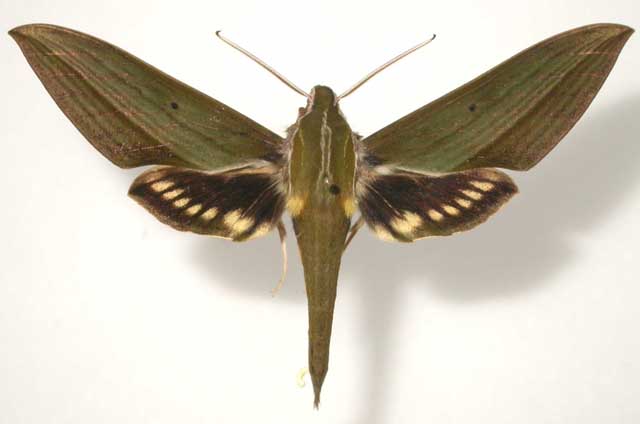
Xylophanes letiranti paratype, Panama,
courtesy of Jean Haxaire.
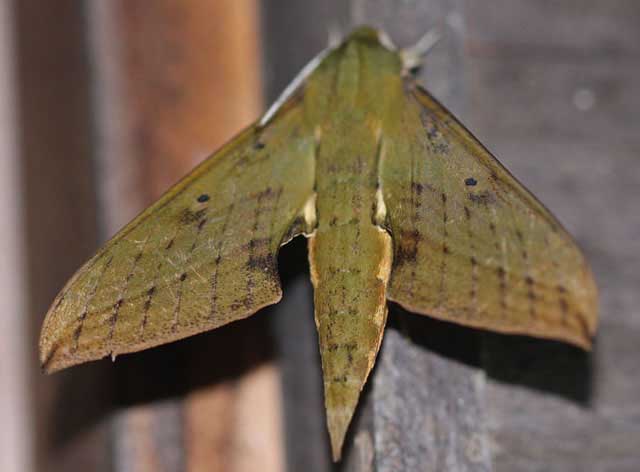
Xylophanes letiranti*, Reserva Natural El Dorado, Santa Marta, Magdalena, Colombia,
March 13, 2011, 1950m, courtesy of Joakim Johansson,
tentative id by Jean Haxaire after consultation with Ian Kitching,
* something else, as yet undescribed (Bill Oehlke, confirmed by Jean Haxaire as something undescribed).
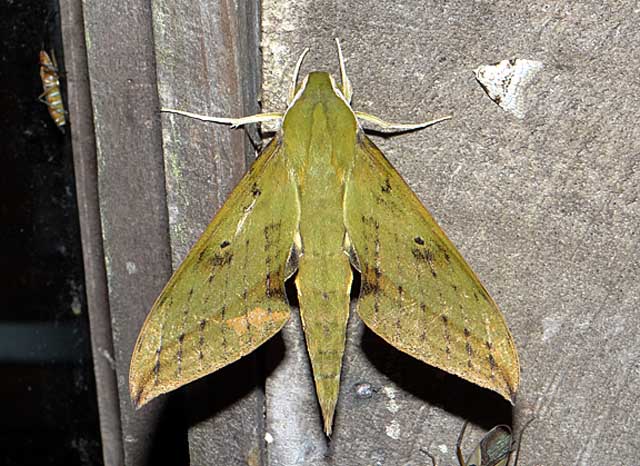
Xylophanes letiranti*, El Dorado, Santa Marta Mountains, Magdalena, Colombia,
courtesy of Robert Behrstock, * something else, as yet undescribed (Bill Oehlke).
This site has been created by
Bill Oehlke at oehlkew@islandtelecom.com
Comments, suggestions and/or additional information are welcomed by Bill.
TAXONOMY:
Family: Sphingidae, Latreille, 1802
Subfamily: Macroglossinae, Harris, 1839
Tribe: Macroglossini, Harris, 1839
Genus: Xylophanes Hubner [1819] ...........
Species: letiranti Vaglia and Haxaire, 2003
|
MIDI MUSIC
.....It's a Wonderful World.....
copyright C. Odenkirk
ON.OFF
<bgsound src="world.mid" LOOP=FOREVER>
|
DISTRIBUTION:
Xylophanes letiranti
flies in
Costa Rica: (specimen type locality: Cordillera de Talamanca, San Jose);
Panama; and
Colombia *: Reserva Natural El Dorado, Santa Marta, Colombia, March 13, 2011, 1950 meter(JJ).
* Presence in Colombia is not confirmed. Images of three different specimen digital images from Santa Marta, Colomobia, all appear to be of a species very similar to
X. letiranti but as yet undescribed.

Xylophanes letiranti male, Cordillera De Talamanca, San Jose, Costa Rica,
on my home computer only.
I had forwarded the images of the Magdalena, Colombia specimen to Jean Haxaire and Ian Kitching, and Jean wrote back after some consultation
with Ian, "After a better investigation, I think the moth is X. letiranti. That would be a new and interesting record from Colombia. I have it from
Panama, so that's not such a great surprise and even logical, many Sphingidae from central America do the same.
"The shape of the discal spot is a good character. I enclose two pictures that could help for the det, but we cannot see really how are the yellow area of the
hindwings. Bill you can use those pictures if you need."
"Similar to Xylophanes crotonis but larger and darker. Antennae more robust than in Xylophanes crotonis.
MaleWingspan: 102-112 mm; hence larger than Xylophanes crotonis.
Forewing upperside very dark green or emerald green or brownish with touches of green (the latter form probably being due to deterioration of the green pigment as
it is seen only in rubbed or faded specimens); a diffuse black patch present distal to the discal spot, between the costa and first postmedian line, contrasting
with the ground colour (in Xylophanes crotonis, this patch, when present, is reduced to two short, thin lines on M2 and M3 distal to the discal spot); all oblique
lines heavier than corresponding lines in Xylophanes crotonis; fourth postmedian line enlarged into a dark, diffuse, triangular patch on the inner margin below CuA2,
reaching distad as far as the second submarginal line.
Oblique black lines on forewing underside straighter and more diffuse than in Xylophanes crotonis.
Pale yellow spots forming the median band on the hindwing upperside smaller than in Xylophanes crotonis and speckled with black scales, giving them a more blurred
and sombre aspect." CATE
After examining the image on CATE website, reading their description of letiranti (above) and examining the images sent to me by Joakim Johansson more carefully,
I wrote back to Jean Haxaire: "I have just looked at the image of Xylophanes letiranti on CATE Sphingidae, and have also put your image attachments and
images from Joakim on same page, and I notice a big difference with regard to markings on the thorax. The image from Colombia seems to totally lack the strong grey
lines (letiranti) on thorax, and of course it has the very strong presence of wing veins creating a checkerboard pattern with pm lines. I think it is not letiranti,
but more likely something new. I have asked Joakim again about availability of specimens and indicated you would love to have it for closer examination.
"Maybe the photograph does not do the Colombia specimen justice with absence/presence of grey thoracic lines, or maybe there is considerable variability with
markings. I also notice the pmls appear much less oblique on the Colombian specimen. It would not be wise, however, to determine/describe a new species just from a
photo!
At least now the location is known and maybe someone will go to that area to
collect to confirm either letiranti or something else."
Acknowledgement: I very much appreciate all the assistance that has come my way from Ian Kitching, Jean Haxaire, the late Jean-Marie Cadiou,
Jim Tuttle, etc., and recognize that every one of them has much more knowledge and experience with Sphingidae than I do. Bill Oehlke
On March 14, 2014, I received the following image from Brian Fletcher. It is much like Joachim's image, but not, to my eye, like the letiranti image.
I think it is something as yet undescribed. Bill Oehlke
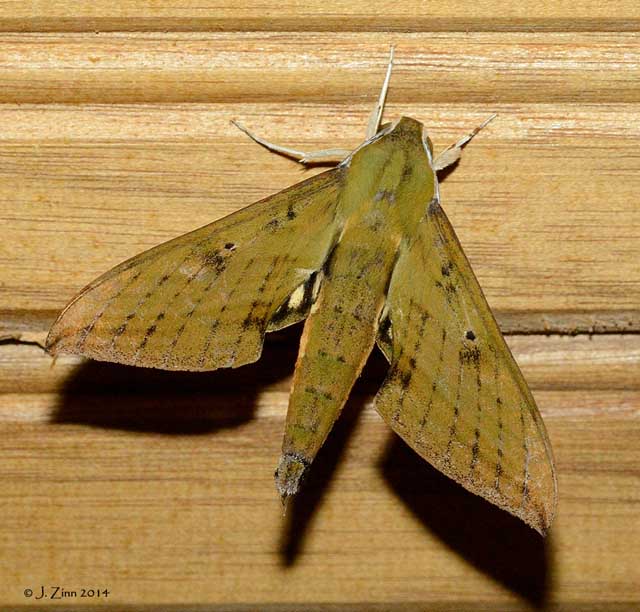
Xylophanes letiranti, El Dorado, Santa Marta Mountains, Guarjira, Colombia,
February 19, 2014, courtesy/copyright of Janet Zinn,
tentative id by Bill Oehlke,
something undescribed (Bill Oehlke).
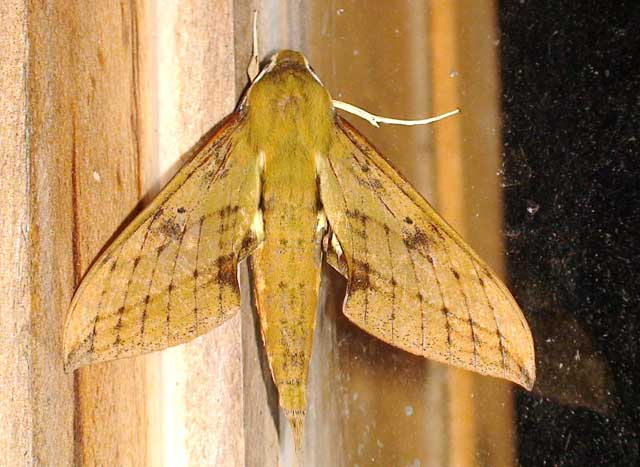
Xylophanes letiranti, El Dorado, Santa Marta Mountains, Guarjira, Colombia,
March 15, 2009, courtesy of Brian Fletcher,
tentative id by Bill Oehlke,
something undescribed (Bill Oehlke).
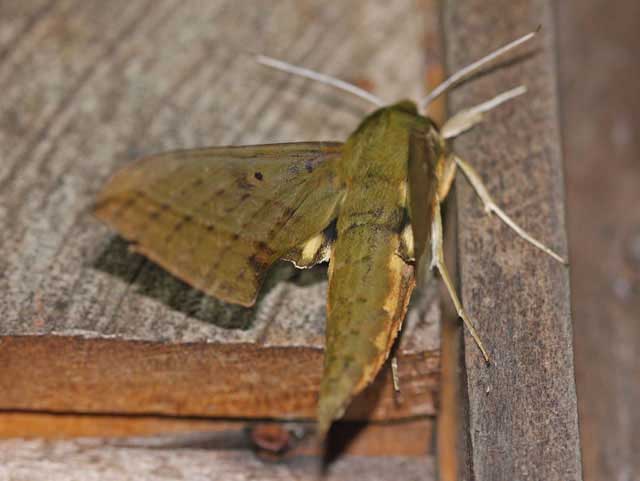
Xylophanes letiranti, Reserva Natural El Dorado, Santa Marta, Magdalena, Colombia,
March 13, 2011, 1950m, courtesy of Joakim Johansson,
tentative id by Jean Haxaire after consultation with Ian Kitching,
something undescribed (Bill Oehlke).
Many thanks to Jean Haxaire who provides the following images highlighting characters of Xylophanes letiranti as compared to Xylophanes crotonis.
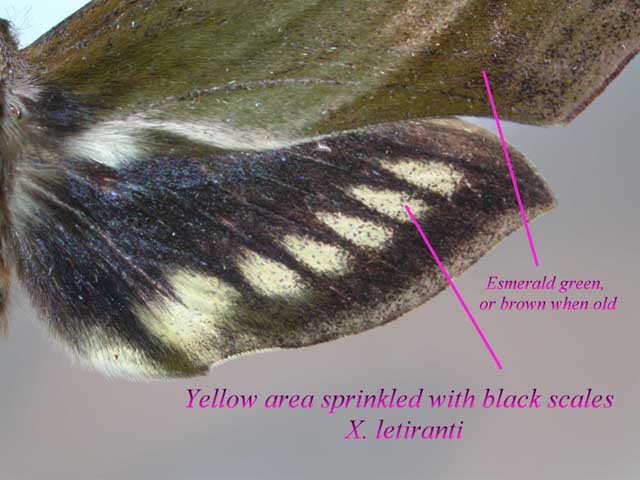
Xylophanes letiranti, courtesy of Jean Haxaire.
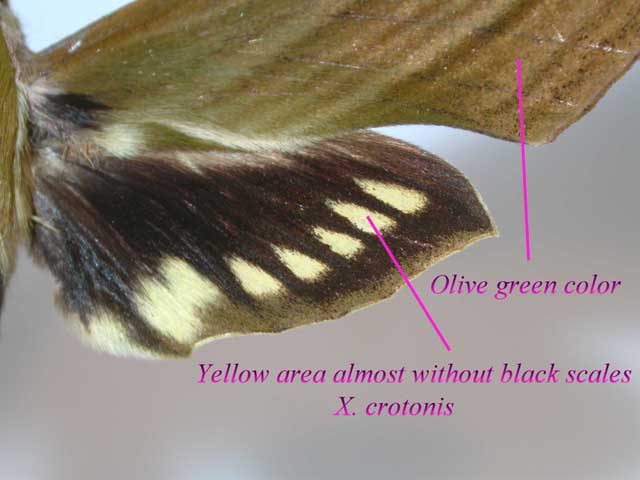
Xylophanes crotonis, courtesy of Jean Haxaire.
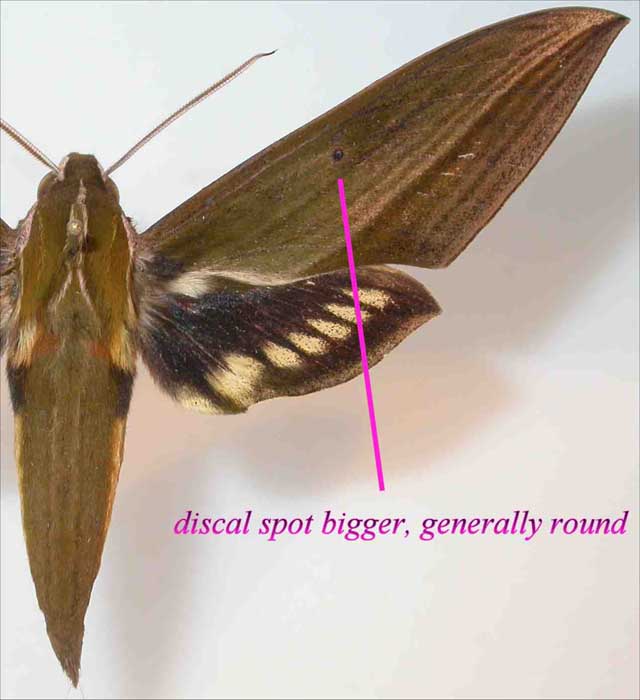
Xylophanes letiranti, courtesy of Jean Haxaire.
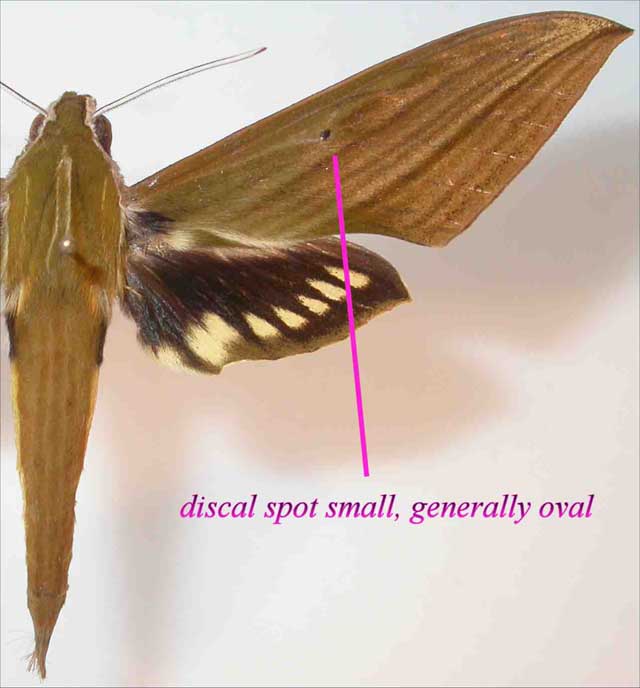
Xylophanes crotonis, courtesy of Jean Haxaire.
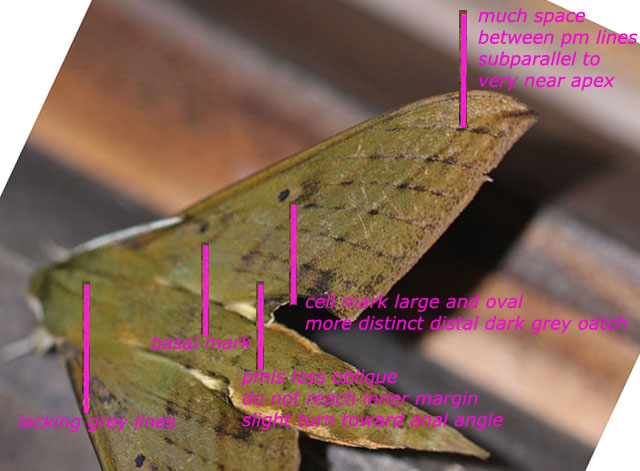
Colombian Xylophanes rotated image.
The angle at which an insect is photographed and its actual natural orientation can greatly influence our perceptions.
I notice the following "differences" between the Colombian specimen and the images of crotonis and letiranti:
1) absence of grey lines on thorax; prominent on crotonis and letiranti;
2) presence of basal, sub-costal dark grey mark on Colombian specimen, not present on crotonis or letiranti;
3) large oval cell spot, followed by more distinct charcoal grey patch;
4) post median lines of Colombian specimen seem less oblique, terminate before reaching inner margin, seem to bend toward anal angle near inner margin, whereas
pmls on crotonis and letiranti continue to a prominent white curve near inner margin, the white curve seemingly missing on the Colombian specimen;
5) prominent wing veins and dark spotting at intersection with pmls could be due to scale loss, but Colombian specimen does not seem that worn;
6) much more space between outer pmlines near the apex of the Colombian specimen.
Brian Fletcher thinks the grainy image below is of another individual "letiranti". The creamy "tear drops" on the hindwing do not display the
black speckling associated with letiranti. I am now convinced (March 2014) this is a species not yet described. Hope somebody soon can get a specimen or at least a
leg sample for DNA barcoding.
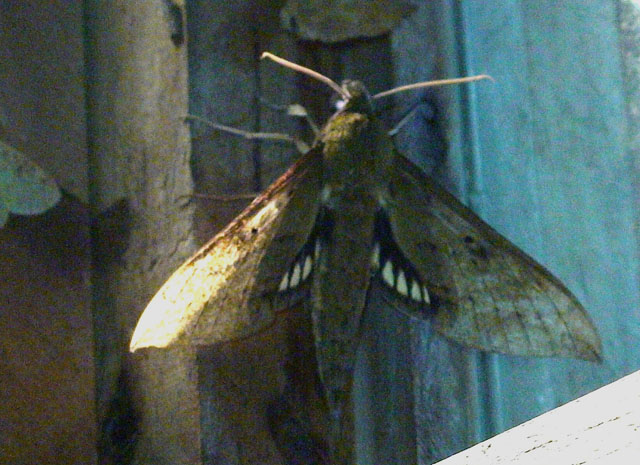
Xylophanes letiranti, El Dorado, Santa Marta Mountains, Guarjira, Colombia,
March 15, 2009, courtesy of Brian Fletcher,
tentative id by Bill Oehlke,
something undescribed (Bill Oehlke).
FLIGHT TIMES:
Xylophanes letiranti adults probably fly as multiple broods.
ECLOSION:
Pupae probably wiggle to surface from subterranean chambers just prior to eclosion.
SCENTING AND MATING:Females call in the males with a pheromone released from a gland at the tip of the
abdomen. Males come in to lights very readily, but females are
seldom taken in that way.
EGGS, LARVAE, PUPAE:
Larvae probably feed on
plants of the Rubiaceae family and of
the Malvaceae family.
Moths emerge approximately one-two months after larvae pupate.
Use your browser "Back" button to return to the previous page.
Goto Main Sphingidae Index
Goto Macroglossini Tribe
Goto Central American Indices
Goto Carribean Islands
Goto South American Indices
Goto U.S.A. tables
The pronunciation of scientific names is
troublesome for many. The "suggestions" at the top of the page are
merely suggestions. They are based on commonly
accepted English pronunciation of Greek names and/or some
fairly well accepted "rules" for latinized scientific names.
In some cases I have anglicized the pronunciations as per
more common usage.
The suggested pronunciations, on this page and on other pages,
are primarily put forward to assist those who hear with internal
ears as they read.
There are many collectors from different countries whose
intonations and accents would be different.
Jean Marie Cadiou writes, "When I say "Xylophanes" in English I
pronounce it something like "Zailophanees", with the emphasis on the
"o". The French pronounce it differently, something like
"Kzeelophaness" with no emphasis, and the Germans yet in a
different way..."
In Greek myth, Phanes is the golden winged Primordial Being who
was hatched from the shining Cosmic Egg that was the source of the
universe. He personifies light emerging from chaos.
"Xylo" is the Greek word for wood.
The specimen type for the genus
Xylophanes is Xylophanes anubus. Perhaps ? when Hubner
examined this species, the yellow-orange and brown tones of the
forewings suggested wings of wood.
The species name "letiranti" is to honnor Stephane Le Tirant, curator of the Montreal Insectarium who discovered the original series.












